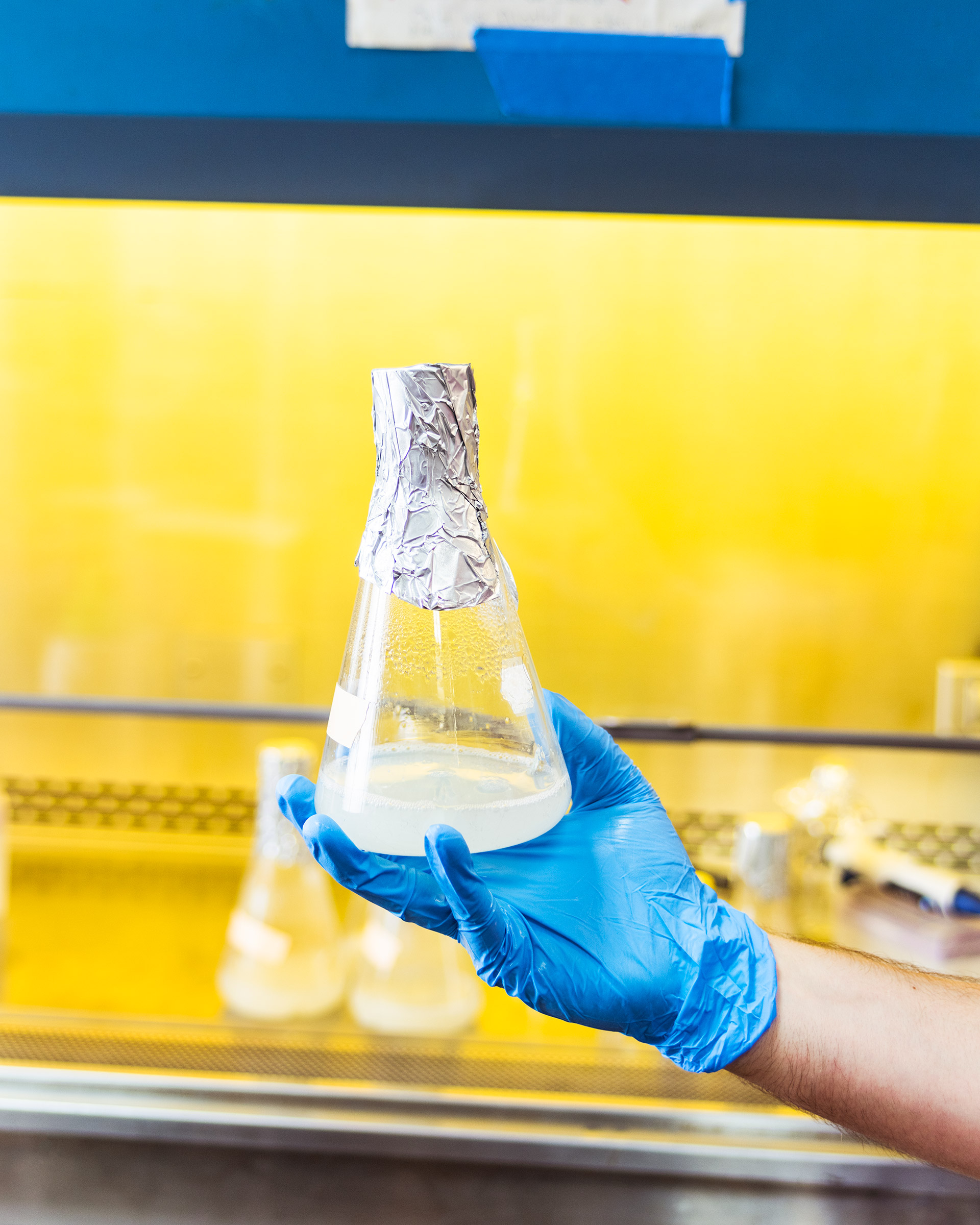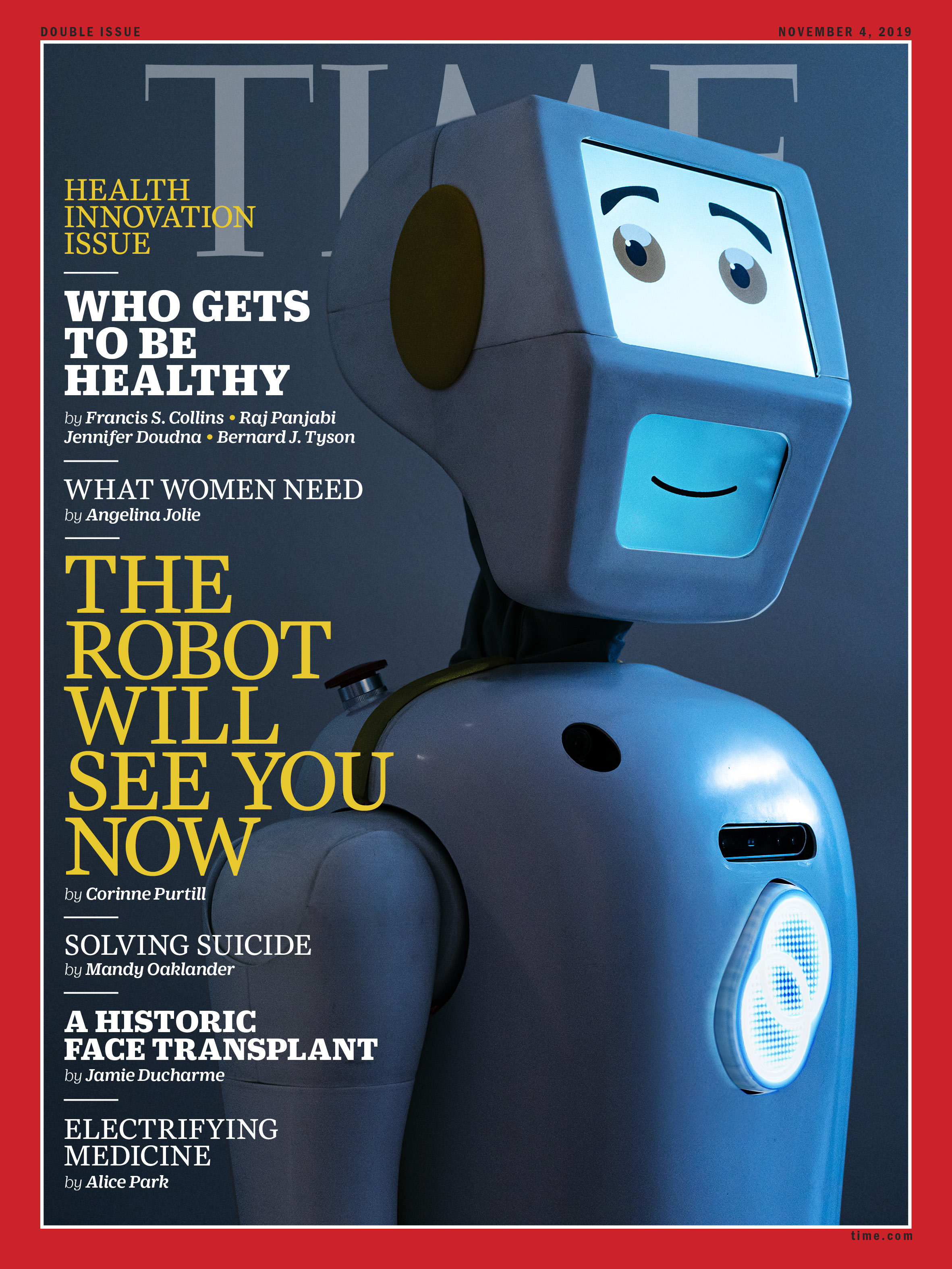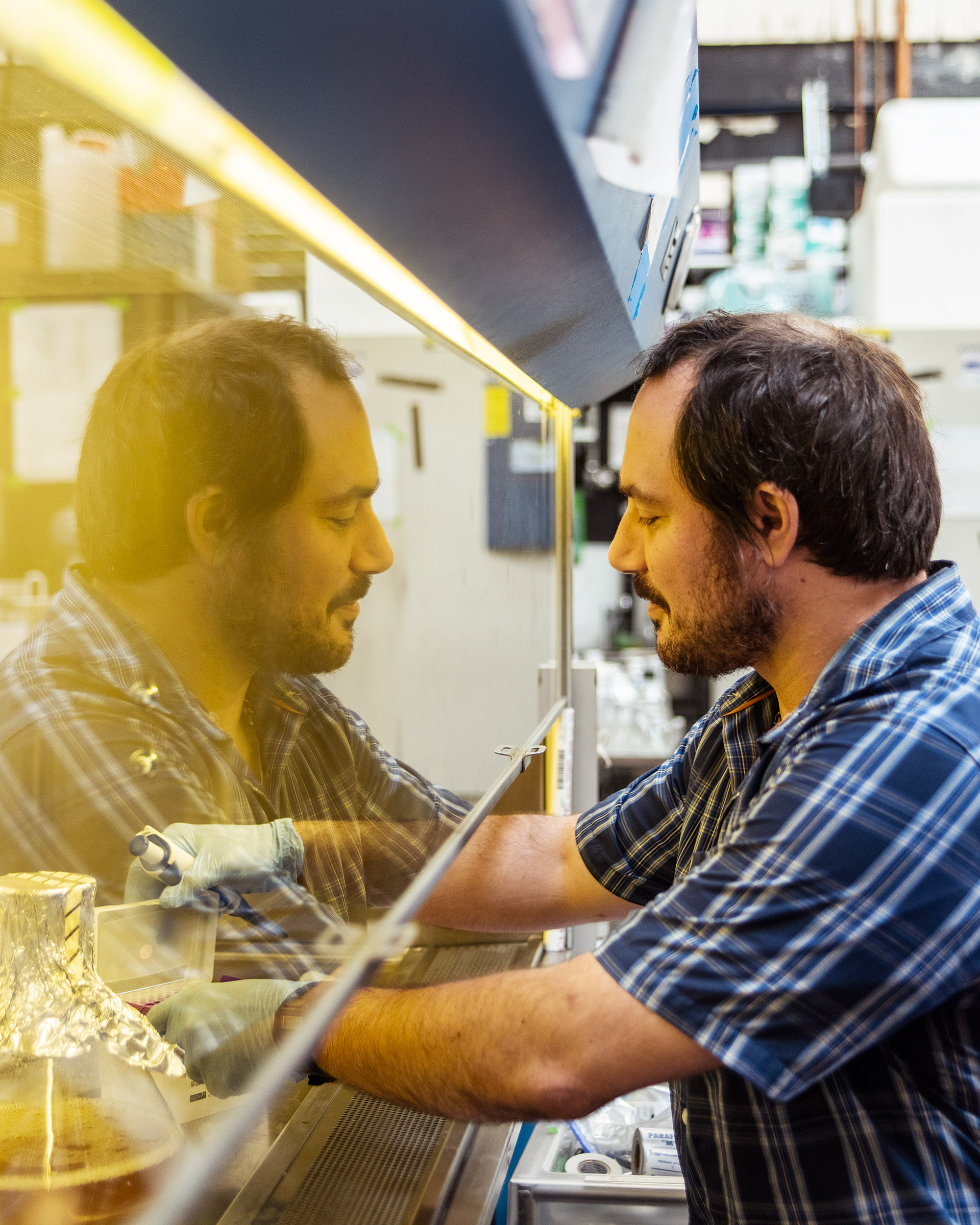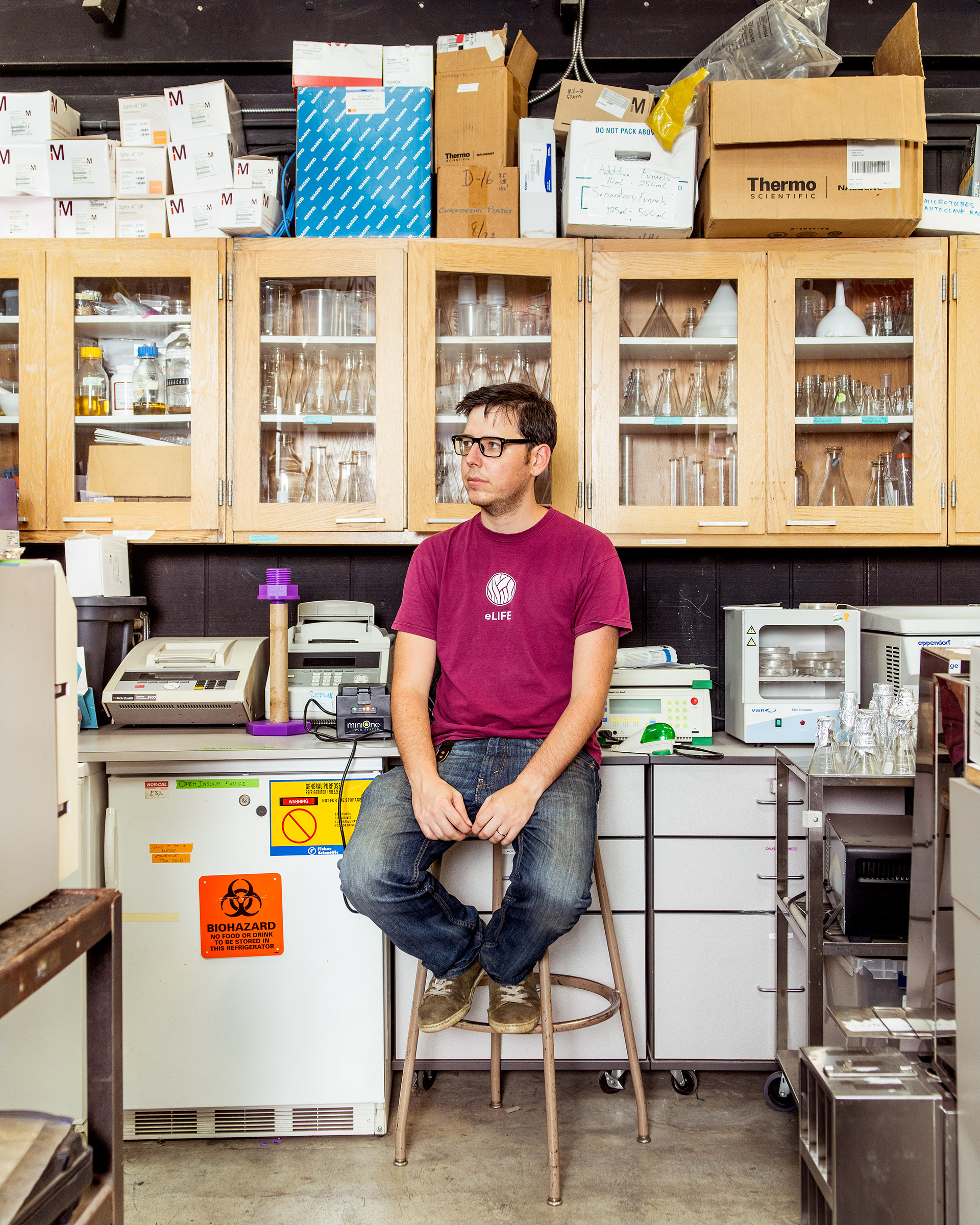
In a hip Oakland, Calif., neighborhood, just blocks from cocktail bars and swanky Mexican restaurants, is an enormous warehouse, home to Counter Culture Labs, ground zero for an audacious challenge to the high cost of prescription drugs. In the entryway stands a 1½-story cardboard T. Rex, and inside it’s a bit as if Dr. Frankenstein shared his lab with a hoarder: cluttered shelves hold piles of drying mushrooms, Clorox wipes, wires, kitchen pots, motor oil, two books about Darwin, ropes, a broken alarm clock, a telescoping magnifying glass, a heat gun, a 3-D printer and several jars of clear liquid with tubes running between them. One shelf holds plastic bins labeled Lab Coats, Paint & Brushes and Ebola Suits.
A group of professional scientists and amateur tinkerers founded Counter Culture Labs in 2013 with the goal of bringing biotechnology to the masses. At any time, it hosts dozens of projects; when I visit in July, there’s one whose objective is to make “vegan cheese” using yeast.
The Open Insulin Project has bigger plans. The group wants to reverse engineer how the world’s largest pharmaceutical companies produce insulin and then turn over the instructions to the public. In theory, anyone with a bit of cash could then build a DIY lab in their garage and make open-source insulin.

Currently three companies—Eli Lilly, Novo Nordisk and Sanofi—control most of the world’s $27 billion insulin market, using a complicated web of regulations and patents to keep a hold on it. Open Insulin wants to rebuild it with no megacorporations and no profit. The project is probably months, if not years, away from actually making medical-grade insulin, but its objective is as much political as it is production-oriented: bringing a sharp focus to the stratospheric price of insulin and, more broadly, the predatory pricing of prescription drugs in the U.S.
Over the past 60 years, the list price of a vial of insulin has gone from about 75¢ to $250—an increase nearly 43 times the rate of the U.S. Consumer Price Index inflation. “High drug costs exist throughout the system, but insulin is the poster child of this broken marketplace,” says Representative Tom Reed (R., N.Y.), one of the chairs of the Congressional Diabetes Caucus. Some, in fact, think that the project is already working as a kind of provocation: a way to force the issue on what is really a policy problem. “If the price of insulin gets regulated, the project will just go away,” says Jean Peccoud, a professor of chemical and biological engineering at Colorado State University.
For now, the project seems to be in a regulatory safe space, but that may change as it gets closer to making actual medicine. In an email, a Food and Drug Administration (FDA) spokesperson acknowledged that the agency is aware of the Open Insulin Project, but noted, “We cannot comment on hypothetical situations or potential future states of regulation.”
Predatory pricing in the U.S. isn’t unique to insulin. A study of the world’s top 20 medications found that Americans pay an average of three times as much as patients in the U.K. do for a given drug. The science behind making insulin is old, which makes it a good first target for the disruption of the pharmaceutical industry.

Anthony Di Franco, one of the Open Insulin Project’s co-founders, has diabetes himself, and has watched as the price of managing his disease has gone up and up. He has a dual undergraduate degree in physics and math/computer science from Yale University and is currently on leave from pursuing his Ph.D. in computer science at the University of California, Davis. He lives on contracting jobs, doing data science and researching machine learning and programming languages. Like many freelancers, he doesn’t have employer-sponsored insurance. But unlike most with the disease, he knew enough about science to start thinking there might be a better way—and so, in 2015, he launched the Open Insulin Project.
“The current system was built to exploit people with diseases,” Di Franco says. “Historians will look back and say, ‘How could they have done such a terrible job?’”
Diabetes is caused when the pancreas can no longer make enough or any insulin, a hormone that regulates blood sugar, or when a person’s body builds up a resistance to the hormone. Insulin, which helps the body use sugar for energy and lowers its levels in the blood, was first used to treat diabetes in the early 1920s. Physician Frederick Banting and medical student Charles Best were working with dogs, inducing diabetes by removing their pancreases and then trying to figure out a cure. The two eventually extracted a substance from cow pancreases; purified it with the help of biochemist James Collip; and proved it worked by injecting it themselves and noting that they got dizzy, a sign of low blood sugar. By 1922, doctors were using insulin from cow pancreases to treat diabetes patients.
People with severe diabetes need insulin injections to stay alive. Without it, your blood turns acidic, your body dehydrates, your vision blurs, you get weaker and start to vomit. Over days, you slowly—and painfully—die.
This fact, coupled with the inefficiencies of the American health system, as well as a manipulable patent framework, has enabled pharmaceutical companies to steadily increase the price of the lifesaving drug, even as it’s become easier and less costly to produce. Generally speaking, drugs are cheap to make. The costs are mostly to pay for the research and development required to discover them. For example, one 2016 study that looked at 106 recently approved drugs from 10 different companies found that the average R&D cost for each was $2.78 billion, compared with only about $19 million per drug in costs of actual clinical trials.
Much of the industrialized world has some form of single-payer health insurance and strict price controls on drugs, usually determined by a board of doctors and experts. In the U.S., the pull of the free market was supposed to keep prices down, but instead has led to a complex system of profit-driven corporations, from manufacturers to insurance companies, who add cost at every juncture.
It wasn’t meant to be this way, especially not with insulin. Banting, who shared a 1923 Nobel Prize for his work on insulin, demanded his name not be put on the patent, believing profiteering off a medicine was unethical. His co-discoverers agreed, transferring their patents to the University of Toronto for $1 each.
The pharmaceutical corporation Eli Lilly and Company of Indianapolis offered to help the university develop the medication, and the school eventually agreed to license the technology. Eli Lilly contracted with slaughterhouses to receive pig pancreases by railroad car in order to squeeze out the insulin. It was crude, but effective—and cheap. Ads from the 1960s show vials of insulin available for 84¢ in the U.S., just $7.36 in today’s dollars. And then came a real breakthrough.
In 1982, Eli Lilly introduced insulin made by genetically modified E. coli bacteria. The new insulin was less likely to cause allergies than the animal version, and it could be grown in vats. Novo Nordisk started making its own bioengineered insulin in 1991, and it looked like the drug was about to get really affordable, thanks to the competitive marketplace. Instead, prices went up. A congressional report written in 2018 found the list price of competing insulin formulations “appeared to rise in tandem,” doubling from 2012 to 2018. According to the report, that was most likely due to limited market competition, and to the fact that “each part of the insulin delivery chain is controlled by a small number of entities.” The marketplace never became competitive.
In theory, the U.S. patent system, which gives manufacturers sole rights to a drug formulation for 20 years, should eventually enable other drug producers to bring cheaper versions of the same medication to the market. But as Reed and the co-chair of the Congressional Diabetes Caucus, Diana DeGette (D., Colo.), note, companies skirt this by “evergreening” their drugs—tweaking drug formulas slightly, often making incremental improvements, to renew the patent and prevent generics from ever entering the market. Lantus, a long-acting insulin patented by Sanofi in 1994, was due to enter the public domain in 2015, but instead the company filed 74 patents for newer versions of the drug, which delayed that until 2031. Novo Nordisk has done something similar with one type of insulin by upgrading the mechanics of its injection pen. These insulins are touted as improvements, although there is evidence these are typically minimal.
“People with diabetes experience different issues and complexities that can’t be covered by one solution, which is why we continue to bring forth programs that will directly benefit even more patients and work toward much needed longer-term systemic reform,” said a Novo Nordisk spokesperson in an email.
An Eli Lilly spokesperson told TIME in an email that the company does not evergreen. “None of our insulins is patent-protected and our most commonly used insulin, Humalog 100, lost patent protection in 2014,” the spokesperson said. While the patent for Humalog 100 has expired, because of the complexities of entering the market, only one manufacturer jumped in to make a version of the drug: Sanofi, which already makes its own formulation. Sanofi’s “generic” version of Humalog sells for just 15% less than its original price. Eli Lilly is also manufacturing an “authorized generic” version, currently selling for 50% of the price.
A Sanofi spokesperson, meanwhile, writes that the company’s original patent on Lantus has expired and subsequent patents “are related to new and unique inventions.” They also point out that despite increases in the listed price for Lantus, the actual price customers pay is lower than it was in 2006, a result of other inefficiencies in the market. The spokesperson added that “we also support a robust and competitive marketplace, including efforts by other organizations to develop new technologies and medicines—including Open Insulin Project.”
For insured diabetics, the high costs of insulin are borne primarily by their insurers, and so remain more or less hidden. But for those without insurance or for people on high-deductible plans that require them to pay for their own care until they hit a predetermined amount, these prices take lives. Alec Smith, a 26-year-old restaurant manager, couldn’t afford the $1,300 a month it took to manage his diabetes. In 2018, Smith was three days from a paycheck when he died alone in his apartment; investigators later found an empty insulin-injection pen in Smith’s home. The case made headlines, but the human price of the high cost of insulin isn’t hard to find. Some 13.2% of the 2.9 million people who take insulin in the U.S. do not take it as prescribed, and 24.4% asked their doctor for a lower-cost medication, according to the CDC.
It’s not going to take a Nobel Prize to make DIY insulin, just persistence. The good news for the Open Insulin Project is that it has the accomplished 33-year-old French biochemist Yann Huon de Kermadec as its lead scientist. He’s in the U.S. right now because his wife Louise Lassalle is a postdoctoral researcher at Berkeley Labs. Huon de Kermadec donates his time, showing up at the lab five to six times a week to work long hours designing a new form of life: a yeast cell genetically engineered to produce a form of insulin people could use.

On his side is the fact that biotech is getting cheap. The same pressures that brought down the cost of total gene sequencing from a taxpayer-funded $2.7 billion project to a $200 drugstore test in under two decades mean you don’t need millions of dollars to start a biotech project anymore. The Open Insulin Project is able to do what it does because equipment has become so cheap—especially in the Bay Area, where high turnover in the biotech industry leads to a glut of second-hand, lab-quality gear—and, like your home computer, more powerful. There are now several companies that market vast databases of genes, searchable by utility, all of which are economical. Huon de Kermadec picked two sequences of genes: one that produces a protein that can be cut to make insulin, and one that makes the yeast resistant to a specific antibiotic.
Using these genes, he and the team created a formula for a plasmid, a tiny circular piece of DNA. Then he hired a company to manufacture a small quantity of these plasmids, which they sent to Counter Culture Labs in a tiny plastic vial. Dozens of companies offer this sort of service in the U.S., at prices as low as a few hundred dollars. Next, the team jammed the plasmids into yeast cells, and added an antibiotic solution to the cell cultures. That’s where the antibiotic-resistance gene comes in handy—the ones that successfully adopt the plasmid into their own DNA will survive, and those that don’t will die out. The next step would be to grow the surviving cells, which should contain the genes to produce both antibiotic resistance and the precursor protein for insulin.
The team thinks they’ve gotten this far. They know the yeast produces a molecule the size of insulin—which is a pretty good sign it is, in fact, insulin. But they’re scientists, so they’re not popping the champagne yet. They want to confirm that the molecule is indeed insulin by using mass spectrometry, a precise technique that allows scientists to identify specific proteins, before they say for sure.
Then they will have to prove their insulin is pure enough to inject into a person. They’ll also have to demonstrate they can make medical-grade insulin every time with their process. Then, to get it to the people, they’ll need to standardize the equipment so other people can manufacture or buy it.
When asked if he thought his team would eventually create a yeast that could produce insulin, Huon de Kermadec responded confidently. “Yes, of course,” he says, “it isn’t rocket science.” But then there are the regulatory hurdles.
Di Franco has been reading up on the history of democracy in ancient Athens and is trying to craft his organization’s bylaws in the spirit of the world’s first democracy. He also wants its product to be democratically affordable: Di Franco thinks roughly $10,000 should be enough to get a group started with the equipment needed to produce enough insulin for 10,000 people. Each of these $10,000 setups would be somewhere between a middle-school science experiment and an industrial laboratory, requiring rooms of equipment; think something closer to a medical-grade brewery than to a countertop bread machine. The resulting product, he says, would cost someone with diabetes dozens of dollars a month instead of hundreds.
That’s noble, in theory, but there’s a reason why the FDA puts a lot of effort into certifying the labs that make our medicines: mistakes can be fatal. The U.S. drug-development system may be expensive, but it does guarantee quality.
The Open Insulin Project falls into a black hole outside of FDA regulation, according to Peccoud, the Colorado State professor. For one thing, the project may skirt some regulations by being a nonprofit. Also, the FDA allows individuals to largely do whatever they want to themselves. “If you want to inject yourself with home-brew beer, there’s no law to stop that,” says Peccoud.
If it does reach a production phase, Open Insulin would have to conform to Good Manufacturing Practice, the FDA rules for factories that make medicine, food, cosmetics and medical devices. And because the group plans to share its insulin-production framework online, crossing state lines, there may be other legal issues on the horizon. One solution might be to partner with other players in the health care system, like hospitals and pharmacies, which create custom versions of everything from acetaminophen to opioids in a process called compounding and navigate the demands of the U.S. system already. However, that’s likely to make the final product more expensive.
Ultimately, it’s not clear that the Open Insulin Project’s real goal is to facilitate insulin minilabs across the U.S. The group intends to put the plan for their designer insulin-producing yeast online as soon as it’s done, but only for “research purposes,” says Di Franco. And without brewing facilities or the ability to check and purify the hormone, the plans themselves are a long way—scientifically and legally—from the point where anyone will be injecting homegrown insulin. Di Franco has offered up his own body as a proving ground once the lawyers sign off: “I’d be thrilled to be the first person to take the insulin,” he says.
There’s ample evidence that insulin doesn’t need to be as expensive as it is in the U.S., even without DIY labs. For one thing, just across the border with Canada, a vial of insulin costs $30. In January 2020, Colorado will become the first U.S. state to put a $100 cap on the co-pays insured patients pay for insulin. Minnesota is considering a similar law.
“It’s an old drug,” says Peccoud. “It’s not hard to produce. It should not be more expensive than Tylenol. Insulin is just pure greed. And a failure of government.”
Correction, Oct. 24
The original version of this story misstated Louise Lassalle’s educational and professional status. She is a postdoctoral researcher at Berkeley Lab, she is not studying for a Ph.D. at Berkeley.
More Must-Reads From TIME
- The 100 Most Influential People of 2024
- The Revolution of Yulia Navalnaya
- 6 Compliments That Land Every Time
- What's the Deal With the Bitcoin Halving?
- If You're Dating Right Now , You're Brave: Column
- The AI That Could Heal a Divided Internet
- Fallout Is a Brilliant Model for the Future of Video Game Adaptations
- Want Weekly Recs on What to Watch, Read, and More? Sign Up for Worth Your Time
Contact us at letters@time.com